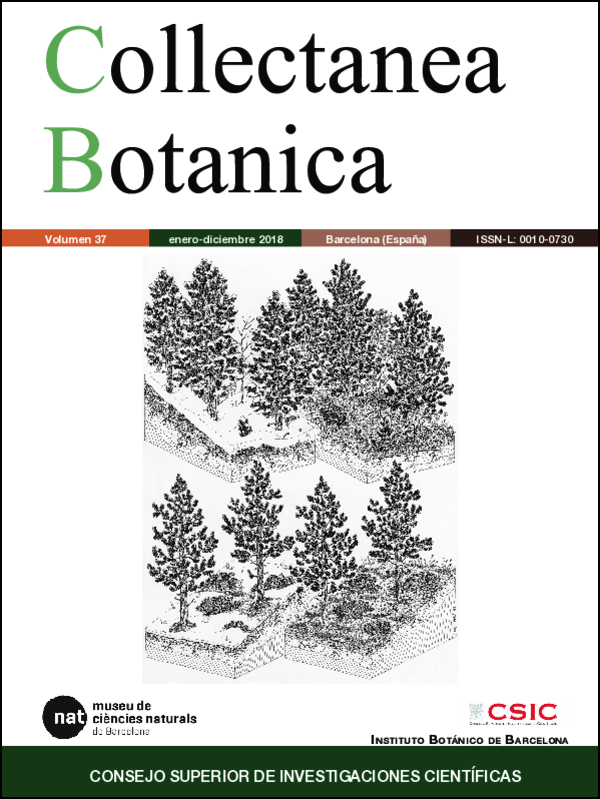On the identity and status of Desmanthus (Leguminosae, Mimosoid clade) in Macaronesia
DOI:
https://doi.org/10.3989/collectbot.2018.v37.007Keywords:
Desmanthus pernambucanus, Desmanthus virgatus, Fabaceae, identification, invasive speciesAbstract
In this paper, the identity and degree of naturalization of Desmanthus (Leguminosae, Mimosoid clade) in the Canary Islands (Gran Canaria, Fuerteventura) and Cape Verde (Santo Antão, São Vicente) are critically re-assessed. The study of morphological features of the plant material sampled allowed to conclude that all specimens must be assigned to D. pernambucanus, instead of D. virgatus as previously thought. Previous records for D. virgatus from Macaronesia still require confirmation but are probably all erroneous. D. pernambucanus is well-established and the number of populations is increasing in the studied area. The species can be classified as an environmental weed or even as a transformer species in natural habitats, often barrancos. The results also show that the distinction between D. pernambucanus and D. virgatus is not always clear-cut and that for an accurate identification the study of living material usually is required.
Downloads
References
Borges, P. A. V., Abreu, C., Aguiar, A. M. F. et al. (Eds.). 2008. Listagem dos fungos, flora e fauna terrestres dos Arquipélagos da Maderia e Selvagens. Direcção Regional do Ambiente da Madeira and Universidade dos Açores, Funchal & Angra do Heroísmo.
Chevalier, A. 1935. Les Iles du Cap Vert. Géographie, biogéographie, agriculture. Flore de l'Archipel. Revue de Botanique Appliquée et d'Agriculture Coloniale 15: 733-1090. https://doi.org/10.3406/jatba.1935.5553
Cook, B. G., Pengelly, B. C., Brown, S. D. et al. 2005. Tropical forages. CSIRO, DPI&F (Qld.), CIAT & ILRI, Brisbane.
Coutinho, A. X. P. 1914. Herbarii gorgonei universitatis olisiponensis catalogus. Arquivos Universidade da Lisboa 1: 265-334.
Diniz, M. A., Duarte, M. C., Martins, E. S., Matos, G. C. & Moreira, I. 2002. Flora das culturas agrícolas de Cabo Verde. Instituto de Investigação Científica Tropical, Lisboa.
Gardiner, C., Kempe, N., Hannah, I. & McDonald, J. 2013. PROGARDES: a legume for tropical/subtropical semi-arid clay. Tropical Grasslands 1: 78-80. https://doi.org/10.17138/TGFT(1)78-80
Hansen, A & Sunding, P. 1993. Flora of Macaronesia. Checklist of vascular plants (4th revised edition). Sommerfeltia 17: 1-295.
Hohenester, A. & Welss, W. 1993. Exkursionsflora für die Kanarischen Inseln. Verlag Eugen Ulmer, Stuttgart.
Jansen, A.-E. 1993. Erhebungen zur segetalflora des regen- und bewässerungsfeldbaus der Insel Santiago, Kapverden. Courier Forschungsinstitut Senckenberg Series 159: 15-23.
Kunkel, G. 1972a. Novedades en la Flora Canaria: VI. Adiciones y nuevas descripciones. Cuadernos de Botánica Canaria 26: 39-45.
Kunkel, G. 1972b. Nuevas adiciones florísticas para las Islas Orientales. Cuadernos de Botánica Canaria 26: 27-38.
Kunkel, G. 1977. Las plantas vasculares de Fuerteventura (Islas Canarias), con especial interés de la forrajeras (Naturalia Hispanica, 8). ICONA, Madrid. PMCid:PMC430660
Linnaeus, C. 1753. Species plantarum 1. Laurentii Salvii, Stockholm.
Luckow, M. 1993. Monograph of Desmanthus (Leguminosae: Mimosoideae) (Systematic Botany Monographs, 38), American Society of Plant Taxonomists, Ann Arbor. PMCid:PMC237841
Mabberley, D. J. 2008. Mabberley's plant-book (3th ed.). Cambridge University Press, Cambridge.
Pengelly, B. & Liu, C. 2001. Genetic relationships and variation in the tropical mimosoid legume Desmanthus assessed by random amplified polymorphic DNA. Genetic Resources and Crop Evolution 48: 93-101. https://doi.org/10.1023/A:1011234913710
Press, J. R., Short, M. J. & Turland, N. J. 1994. Flora of Madeira. Natural History Museum, London.
Richardson, D. M., Py?ek, P., Rejmánek, M., Barbour, M. G., Panetta, F. D. & West, C. J. 2000. Naturalization and invasion of alien plants: concepts and definitions. Diversity and Distributions 6: 93-107. https://doi.org/10.1046/j.1472-4642.2000.00083.x
Sanz-Elorza, M., Dana, E. D. & Sobrino, E. 2005. Aproximación al listado de plantas vasculares alóctonas invasoras reales y potenciales en las islas Canarias. Lazaroa 26: 55-66. https://revistas.ucm.es/index.php/LAZA/article/view/LAZA0505110055A.
Schmidt, J. A. 1852. Beiträge zur Flora der Kapverdischen Inseln. Heidelberg.
Scholz, S., Reyes-Betancort, J. A. & Wildpret de la Torre, W. 2013. Adiciones a la flora vascular de Fuerteventura (Islas Canarias). III. Botánica Macaronésica 28: 99-116.
Silva Vieira da, R. M. 2002. Flora da Madeira: Plantas vasculares naturalizadas no arquipélago da Madeira. Museu Municipal do Funchal, Funchal.
Thiers, B. 2017. Index Herbariorum: A global directory of public herbaria and associated staff. New York Botanical Garden's Virtual Herbarium. The New York Botanical Garden, New York. Retrieved August, 2017, from http://sweetgum.nybg.org/science/ih/
Vidigal, M. P. 1996. Mimosaceae. In: Paiva, J. (Ed.), Flora de Cabo Verde. Plantas vasculares 43. Praia, Lisboa. PMid:9283656
Wagner, W. L. & Herbst, D. R. 1995. Contributions to the flora of Hawai'i. IV. New records and name changes. Bishop Museum Occasional Papers 42: 13–27.
Wu, D. L. & Nielsen, I. C. 2010. Mimoseae. In: Wu, Z. Y., Raven, P. H. & Hong, D. Y. (Eds.), Flora of China 10. Science Press, Beijing & Missouri Botanical Garden Press, St. Louis: 50–54.
Published
How to Cite
Issue
Section
License
Copyright (c) 2018 Consejo Superior de Investigaciones Científicas (CSIC)

This work is licensed under a Creative Commons Attribution 4.0 International License.
© CSIC. Manuscripts published in both the print and online versions of this journal are the property of the Consejo Superior de Investigaciones Científicas, and quoting this source is a requirement for any partial or full reproduction.
All contents of this electronic edition, except where otherwise noted, are distributed under a Creative Commons Attribution 4.0 International (CC BY 4.0) licence. You may read the basic information and the legal text of the licence. The indication of the CC BY 4.0 licence must be expressly stated in this way when necessary.
Self-archiving in repositories, personal webpages or similar, of any version other than the final version of the work produced by the publisher, is not allowed.














